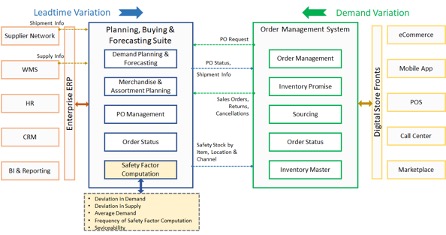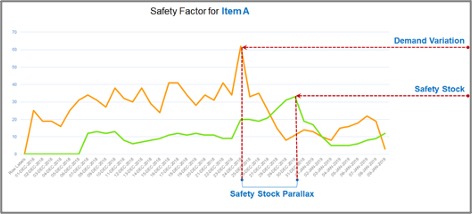
Think Tank
The Problem With Safety Stock — and How to Get It Right

In a world of artificial intelligence and machine learning, big data and analytics, the age-old problem of supply and demand continues to persist even to this day. We’ve yet to attain the nirvana of supply always matching the demand. In attempting to do so, retailers strive to carry extra buffer at every outlet.
The formal definition of safety stock is “the amount of stock of an item that a store or a warehouse must carry to meet the oncoming demand without resulting in stockout.” Retailers looking to determine the proper stocking levels at each store are mostly influenced by the demand cycle illustrated in Figure 1.

Figure 1: A typical supply and demand cycle.
Herein lies all the problem. First, this is not the most accurate way to do it, because the computations often ignore the supply cycle. Second, the supply and demand cycles are disconnected. With many top retailers, safety stock is a value that a merchandiser sets manually and reluctantly. For some retailers it’s a hypothetical number, for others, it’s too canonical and tedious to use. Seldom have I come across a retailer who leverages this concept based on empirical evidence and derives value out of it.
These practices that employ partial information often result in inaccurate stock quantities, resulting in stockouts that causes $1 trillion in losses for retailers globally every year. To add to the challenge, it is an omnichannel world out there. This means demand from one channel can affect the demand from another. A popular item going on sale online can exhaust the stock for customers buying online and picking up in store (BOPIS).
For safety stock to become an empirical value, applications orchestrating supply (procure-to-pay) and demand (customer-order) cycles illustrated in Figure 1 must be very well connected. Both are amiss with most retailers, because except for demand pattern and stock levels, the applications facilitating these cycles continue to remain a silo. Further, there’s minimal awareness about lead-time variation and a lack of tracking of this metric for every item at every location — warehouses, distribution centers, stores and micro-fulfillment centers.
The problem can be overcome if retailers take care of the following details:
Track the lead-time variation. Lead time is measured from the time a purchase order is placed for an item until it’s received at the warehouse and becomes a sellable piece of stock in the system.
Decide on the mathematical formula to compute safety stock. Accommodating for peaks is affected by how frequently you compute.

Figure 2: Application architecture and information flow to achieve seamless safety stock computation.
Understand the influence of supply and demand cycles. Both affect the computation of safety stock for an item at a location, but the influence of the demand cycle is 10 times more than that of the supply cycle.
Accommodate for auxiliary stock into the formula. Understand the usage of stock for visual merchandising and other promotional activities at a store, and add those to your formula.
Compute safety stock value by item, location, and channel. Every channel — e-commerce, mobile, social media and stores — is susceptible to variation in the demand for an item. It’s therefore important to isolate these spikes and compute the safety stock independently by channel, item and location.
Extend the demand forecasting engine to compute safety stock. In the current scheme of applications that retailers employ, demand forecasting application is the most appropriate application to undergo this extension to calculate safety stock.
Integrate demand forecasting engine with order orchestration. Once the values have been computed, and merchandisers have replenished every location with those stock counts, the information must flow to an application that promises inventory and orchestrates the order. Figure 2 provides an illustration of how this can be accomplished.

Figure 3: Weekly computation showcasing a proportional ripple of the safety stock computation.
Compute safety stock at regular intervals. Do it as frequently as possible. If you compute it every week, it takes a week for the new values to apply and might not help if there are no further spikes for that item at that location. Figure 3 showcases how the spike causes a ripple (parallax) a week later in safety stock values for a frequency of weekly computation.
Start with items going out of stock. For any corrections and enhancements like the one discussed in this article, it’s important to decide on a logical and strategic starting point. For retailers with hundreds of thousands of items multiplied by thousands of locations, that can be difficult to do. You should therefore start with those items that are going out of stock across the network. Apply the formula, re-compute the stock levels, observe how the new levels are resilient to the variations in supply and demand, then extend it to a product category or two. Finally, you can compute for the entire catalog on a daily basis.
When it comes to safety stock, it’s important to accurately compute both its value and the frequency of that computation. Retailers need to treat safety stock as a dynamic to be derived from empirical evidence, instead of devising a hypothetical number that’s reluctantly set by someone from the business.
Guruprasad Nagaraja is enterprise architect for retail and supply chain with Tietoevry.






